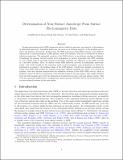Determination of Near-Surface Anisotropy From Surface Electromagnetic Data
Author(s)
Al-Dajani, AbdulFattah; Morgan, Frank Dale; Toksoz, M. Nafi; Repperty, Philip
Downloaddajani.pdf (361.7Kb)
Other Contributors
Massachusetts Institute of Technology. Earth Resources Laboratory
Metadata
Show full item recordAbstract
Ground penetrating radar (GPR) signatures, such as reflection moveout, are sensitive to the presence of azimuthal anisotropy. Azimuthal anisotropy can occur as an intrinsic property of the medium and/or due to the presence of fractures. In such cases, the GPR normal moveout (NMO) velocity, along different orientations of common-midpoint (CMP) gathers, varies with azimuth. This fact is well known in surface reflection seismology. The azimuthal variation of the NMO velocity in an arbitrary medium is elliptical. Considering the analogy between seismic wave propagation in surface seismology and GPR sounding, we can transfer some of the ideas between both fields, including the ellipticity of the NMO velocity in a fractured medium. Here, we discuss briefly GPR reflection moveout in azimuthally anisotropic media. Our study focuses on the transverse mode of electromagnetic wave propagation in which the polarization is normal to the incidence plane of the CMP gathers. A field data example is presented in which three GPR CMP gathers are acquired along three different azimuths, 60° apart, over a fractured medium. Our data analysis demonstrates the azimuthal variation of the GPR NMO velocity, which is utilized to invert for the local orientation of the fracture system in the near surface. The results obtained from the field example agree with the information obtained from geology and near surface studies. This work has important applications in imaging near surface geologic structures and in the determination of tectonic-induced fractures in the near surface.
Date issued
2001Publisher
Massachusetts Institute of Technology. Earth Resources Laboratory
Series/Report no.
Earth Resources Laboratory Industry Consortia Annual Report;2001-10